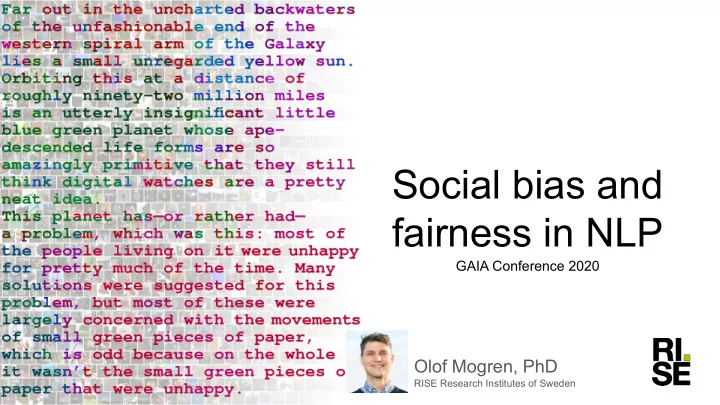

Social bias and fairness in NLP GAIA Conference 2020 Olof Mogren, PhD RISE Research Institutes of Sweden
Natural language processing (NLP) A field of research. Language data : language: a kind of protocol for inter-human communication; discrete Tasks : classification, translation, summarization, generation, understanding, dialog modelling, etc. (many; diverse) Solutions : many; diverse.
Word embeddings was transfer learning for language king queen Stockholm ● (’kings’, 0.71) ● (’queens’, 0.74) ● (’Stockholm_Sweden’, 0.78) ● (’queen’, 0.65) ● (’princess’, 0.71) ● (’Helsinki’, 0.75) ● (’monarch’, 0.64) ● (’king’, 0.65) ● (’Oslo’, 0.72) ● (’crown_prince’, 0.62) ● (’monarch’, 0.64) ● (’Oslo_Norway’, 0.68) Distributional hypothesis: words with similar meaning occur in similar contexts. (Harris, 1954)
Word embeddings was transfer learning for language E.g. Prediction ● Multi-document summarization (1) ● Translation Processing ● Text classification Learned or rule-based Representation Auxilliary data Learned Data 1. Kågebäck, Mogren, Tahmasebi, Dubhashi (2014)
Deep transfer learning for language ● Transformer (BERT) ● Trained using language modelling (word co-occurrences) ● Can compute word embedding that changes according to context ● “NLP’s Imagenet moment”: deep transfer learning for NLP, pretrain deep models. ● E.g. QA, Reading comprehension, Natural language inference, translation, constituency parsing, etc. Vaswani, et.al. (2017), Devlin, et.al. (2018), Peters, et.al. (2018)
Man is to computer programmer as woman is to homemaker gender bias in Word2vec Bolukbasi, et.al., (NeurIPS 2016)
Brittleness in textual entailment Gender-bias in coref resolution Gender-bias in language generation Kai-Wei Chen
Also in Swedish! Also in BERT! ● Gender-bias in Swedish pretrained embeddings ● Gender vs occupation ● Word2vec, FastText, ELMO, BERT Sahlgren & Ohlsson (2019)
Human-like bias in Glove and Word2vec ● Insects and flowers (pleasantness) ● Musical instruments vs weapons (pleasantness) ● Racial bias: European-American names vs African-American names ● Gender and occupations ● Gender and arts vs sciences/mathematics Caliskan, et.al. (2017)
? Don’t we want the model to be true to the data? All dimensions in an embedding may be desired But social bias may be problematic for downstream applications eg: ● Resume filtering ● Insurange, lending, hiring ● Next word prediction on your phone ● Some systems may actually perform worse, cf. coreference resolution We need to know what we are modelling, and how data can be used for this.
Social bias Fairness Disentanglement ● E.g. Gender bias, ● Is an individual ● Attributes are often racial bias, etc. treated fair in a correlated ● On what attributes decision? ● Underlying factors can we base a (Demographics, decision? etc) Generalization ● How can we Privacy isolate them? ● Learn distribution, ● What attributes not datapoints about myself do I share? How do we make models react to certain information but not to all of it?
Approaches Data augmentation Calibration Adversarial representation ● Train models using ● Identify sensitive learning augmented data. dimensions ● he/she ● Modify ● Train to make it ● Anonymization of difficult for names adversary What is it that we want to model, and how do we go about it?
Data augmentation “Anti-stereotypical” dataset. Swap biased words, e.g.: ● he/she ● Anonymization of names ● Wino-bias dataset Zhao, et.al., Gender Bias in Coreference Resolution: Evaluation and Debiasing Methods, NAACL 2018
Calibration ● Restrict sensitive attributes to 1. Identify “appropriate” gendered words specific dimensions of embedding (e.g. grandfather-grandmother, guy-gal) 2. Train model to identify these words ● Minimize distance between words 3. Identify gender direction in the two groups in other 4. Modify vectors dimensions a. Neutral words: zero gender direction(s) b. Acceptable gender words: equidistant to neutral words in gender direction(s) Bolukbasi, et.al. (NeurIPS 2016) Zhao, et.al. (EMNLP 2018)
Counterfactual fairness A decision is the same to an individual in ● the actual world and ● in a counterfactual world, belonging to a different group Kusner, et.al., Counterfactual Fairness, NeurIPS 2017
Adversarial representation learning for privacy ● Privacy preserving machine learning Synthetic non-smile ● Adversarial representation learning for ○ Removing sensitive attributes ○ Synthetize attribute values independent from input ● Paper under submission to ICLR 2021 ● Ongoing project: Input 2 ○ DATALEASH: with (Digital futures/KTH/SU) Input 1 Synthetic smile Martinsson, J., Listo Zec, E., Gillblad, D., Mogren, O. Adversarial representation learning for synthetic replacement of private attributes. https://arxiv.org/abs/2006.08039, 2020.
Adversarial representation learning for language ● Adversary: detect privacy leakage in embeddings ● Embeddings: fool adversary ● Privacy preserving embeddings ● (Requires data augmentation) Zhang, et.al., (AIES 2018), Friedrich, et.al. (ACL 2019),
Thank you Team and collaborators: Olof Mogren, PhD RISE Research Institutes of Sweden olof.mogren@ri.se
References Bolukbasi, et.al., NeurIPS 2016, Man is to Computer Programmer as Woman is to Homemaker? Debiasing Word Embeddings Aylin Caliskan, Joanna J Bryson, and Arvind Narayanan. 2017. Semantics derived automatically from language corpora contain human-like biases. Science 356(6334):183–186 Zhao, et.al, EMNLP 2018, Learning Gender-Neutral Word Embeddings Sahlgren & Ohlsson, 2018, Gender Bias in Pretrained Swedish Embeddings Kiela & Bottou, EMNLP 2014, Learning Image Embeddings using Convolutional Neural Networks for Improved Multi-Modal Semantics Kågebäck, Mogren, Tahmasebi, Dubhashi, 2014, Extractive summarization using continuous vector space models Zhao, et.al., NAACL 2018, Gender Bias in Coreference Resolution: Evaluation and Debiasing Methods Zhang, et.al., AIES 2018, Mitigating Unwanted Biases with Adversarial Learning Sato, et.al., ACL 2019, Effective Adversarial Regularization for Neural Machine Translation Wang, et.al., ICML 2019, Improving Neural Language Modeling via Adversarial Training Martinsson, J., Listo Zec, E., Gillblad, D., Mogren, O. Adversarial representation learning for synthetic replacement of private attributes. https://arxiv.org/abs/2006.08039, 2020. http://kwchang.net/talks/genderbias
Recommend
More recommend